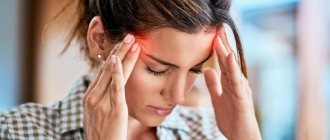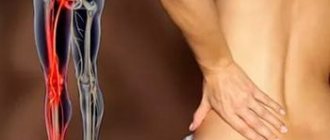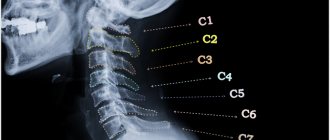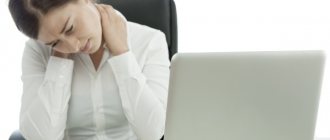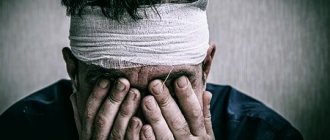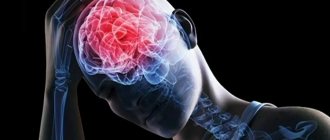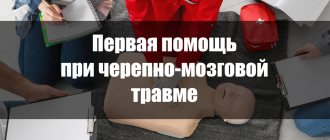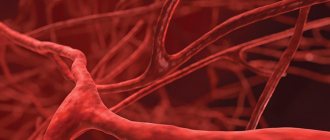According to statistics, every 5 patients at an appointment with a neurologist may experience a burning sensation in the back of the head. These symptoms may include pain, high blood pressure, a feeling that the heart is about to “jump out”, a feeling of anxiety, frequent dizziness, redness of the eyes, patients complain that the back of the head is burning and baking. Why does the back of my head burn? The answer is in this article.
The pain can be so intense that the neck and back of the head literally “burn” with fire. This kind of burning pain is dangerous. A person cannot endure such pain and almost always suppresses it with painkillers. It is not recommended to carry out self-treatment until the exact cause of the heat in the head is determined.
Pain in the back of the head and neck brings a lot of suffering to a person
There are quite a few reasons that cause a burning sensation in the neck and back of the head. These include inflammation, hormonal imbalances, and insufficient blood flow to the brain. The main diseases in which the back of the head and upper back burn:
- cervical osteochondrosis;
- muscle spasms;
- arterial hypertension;
- VSD – vegetative-vascular dystonia;
- migraine, cephalalgia (headache);
- high body temperature due to inflammatory processes.
Often, a burning sensation can occur not only in the head, but also in the shoulders, neck, and chest. Each of these signs is associated with a specific disease. In the article we will pay special attention to the symptoms and treatment of burning pain in the back of the head.
In this article we will tell you in detail about the causes of a burning sensation in the back of the head, treatment with medications, and help at home.
How symptoms may appear
A burning sensation in the scalp can manifest itself in different ways:
- burning inside the head;
- attacks appear periodically;
- feeling as if overheated in the sun;
- tightening of the skin on the head;
- monotonous throbbing pain inside the head;
Throbbing pain in the head can indicate many diseases - heat in forehead;
- pulls the throat and neck;
- pain in temples;
- girdle pain - it seems to arise inside and covers the entire head;
- burning in the cervical region.
Factors that provoke a burning sensation in the back of the head
For many people, the back of the head and ears may “burn” due to external factors, and not due to illness. To eliminate discomfort, you just need to change your lifestyle and habits.
The following factors can provoke the appearance of a burning sensation in the head and neck:
- Smoking and alcohol. Harmful substances enter the blood and lead to vasoconstriction. The body begins to receive less oxygen, which leads to headaches. If you stop drinking and smoking, the symptoms will go away within 2 weeks;
Cigarette composition - Severe fatigue and overwork. High physical and mental stress negatively affects the human autonomic system and therefore blood circulation in the vessels is disrupted. To eliminate symptoms, you need to get enough sleep and avoid overexertion;
- Sedentary lifestyle. Constant sedentary work at the computer and lack of exercise leads to a slower metabolism and poor blood circulation. Painful sensations may decrease by rubbing the back of the head;
- Constant stress and nervous tension;
- Hormonal disbalance. As a rule, this occurs in girls during pregnancy or menopause. This leads to disruptions in the functioning of the heart and provokes painful symptoms in the head and back of the head;
During pregnancy, the head and back of the head may sometimes hurt - Allergies to food, shampoos or cosmetics.
Diseases that cause a burning sensation in the back of the head
Experts identify at least a couple of dozen diseases that are accompanied by a burning sensation in the back of the head. Each of them requires special treatment aimed at the source of the problem. Fighting the symptom itself will not give the desired effect. Usually, when the back of the head burns, the condition is aggravated by a whole set of additional symptoms. Features of the clinical picture make it possible to assess the seriousness of the situation and make a preliminary diagnosis. Only after this can you begin therapy.
Cervical osteochondrosis
The disease develops against the background of destruction of the cartilage and discs that separate the constituent elements of the spinal column. The process is accompanied by the formation of salt deposits, displacement of the vertebrae, pinched nerves, and compression of blood vessels. The result is oxygen starvation of the brain, disruption of the innervation of the tissues of the head.
Clinical picture of the disease:
- cephalgia of aching or spastic type, which intensifies with sudden movements, mental work, turning the head, rolling the eyes;
- burning in the back of the head, sensations can spread to the upper back, shoulders;
- facial redness;
- crunching in the neck when turning the head;
- decreased sensitivity of the skin of the neck and shoulders;
- numbness of fingers or entire limbs;
- dizziness, nausea, poor coordination.
The cause of the problems is an unhealthy lifestyle, refusal of physical activity, and improper organization of the process of working at the computer. Risks increase if a person is overweight, smokes, or drinks alcohol. An important point in disease prevention is sleeping on a suitable mattress, comfortable pillow
Panic attacks
This term refers to a surge of inexplicable anxiety, fear, and panic. The condition is accompanied by vegetative symptoms, the set of which may vary. In most cases, the victim feels burning pain in the back of the head, which intensifies due to a feeling of internal tension. The phenomenon occurs as an independent condition or accompanies hormonal disorders, phobias, heart disease, or taking medications.
The course of panic attacks is accompanied by at least four of the following symptoms:
- tachycardia;
- increased sweating;
- chills - it may not be related to temperature, but may be a manifestation of internal trembling;
- shortness of breath, feeling of lack of air;
- discomfort in the heart area;
- nausea or abdominal pain;
- unpleasant lightness in the head, unsteady gait, a feeling of imminent blackout;
- loss of connection with reality;
- fear of death, inappropriate action, madness;
- numbness of the limbs or tingling in the muscles;
- confusion of thoughts, inability to concentrate on goals;
- sleep disorders.
Read also: Triptans: drugs for migraines
The average duration of an attack is 15-30 minutes, but it can last for hours. The frequency of exacerbations depends on individual characteristics. Patients note the suddenness of panic attacks. They are often associated with being in a crowd, riding in an elevator or on public transport.
Chronic fatigue
A feeling of compression and swelling in the back of the head, heat in the back of the head often bothers those people who neglect their daily routine. Physical stress is complemented by emotional stress. All this accumulates and leads to disruption of blood flow in the vessels and brain hypoxia. Attempts to refuse rest, forcing the body to work at its limit, are fraught with the development of chronic problems.
Tension headaches are rarely the only symptom of a problem. It is complemented by arrhythmia, loss of appetite, and changes in blood pressure. The person becomes irritable and capricious. His sleep is disturbed, and unreasonable fears appear. Against this background, the likelihood of developing infectious diseases increases.
Mental stress
The problem most often occurs in women over 30 years of age. Patients describe the sensation as heat in the back of the head, which is accompanied by psycho-emotional instability. Symptoms can occur suddenly, but most often they are provoked by quarrels, shock, and worries. For a pathological condition to develop, a person must experience stress and overexertion for a long time. Soreness is the result of spasm of the muscles of the neck and head, and impaired blood circulation in the tissues of the cranium. If left untreated, the problem threatens to develop into neurosis, psychosis, and panic attacks.
Arterial hypertension (hypertension)
One of the most common causes of a burning sensation in the back of the head. Increased blood pressure largely affects the artery that runs through the neck from the spine to the brain. Its walls become overstrained, the vessels dilate, and blood actively rushes to the area, which provokes a burning sensation. The clinical picture is complemented by bursting cephalalgia, weakness, spots before the eyes, and dizziness. Patients complain of tinnitus, nausea, sweating, and pressure on the eyes. In the absence of medical care, the phenomenon can provoke a hypertensive crisis or hemorrhagic stroke.
Occipital neuralgia
Painful sensations in the area where the nerve endings are located occur due to pressure on them from tumors, inflamed or swollen tissues, and the formation of foci of infection.
A burning sensation in the back of the head is complemented by a loss of sensitivity in the problem area and the appearance of goosebumps. Symptoms intensify with palpation of the skin, turning the head, coughing, and active use of facial expressions. The sensations are practically not relieved by taking analgesics. Neuralgia can accompany dangerous conditions such as meningitis, encephalitis, and stroke. For this reason, diagnosis must be quick and professional.
Spondylosis
Metabolic disorders, old age, a sedentary lifestyle, and injuries can provoke pathological growth of bone tissue in the anterior parts of the vertebrae. As a result, osteophytes appear on them. These formations irritate the surrounding tissues, reduce the mobility of the spine, and limit its functionality.
The pathology may occur without obvious symptoms, but when the problem is located in the cervical region, the clinical picture is almost always obvious. The patient experiences a burning sensation in the back of the head, which radiates to the ears and eyes. The pain intensifies when moving. The quality of sleep decreases, and muscle stiffness persists even after rest.
Read also: What can a lump on the back of your head mean?
Hypothermia
Prolonged exposure to low temperatures on muscles leads to inflammation. Being in a draft, refusing to wear a scarf or high collar in cold weather lead to such a negative consequence. The pain is concentrated in the sore muscle. It resembles a burning sensation and can radiate to other parts of the head and neck. In serious cases, swelling may appear in the problem area,
Intracranial hypertension
An increase in the volume of cerebrospinal fluid in the skull or its pathological pressure on the substance and membranes of the brain provokes severe cephalgia. This can occur against the background of infectious diseases, head or spinal injuries, tumor formation, hydrocephalus, long-term medication use, and cerebral edema. The headache has a bursting, burning character. Most often it is concentrated in the back of the head, but can spread throughout the head. The clinical picture is complemented by nausea, vomiting, dizziness, weakness, and loss of coordination.
VSD or vegetative-vascular dystonia
The name hides a list of various symptoms provoked by various reasons. They are associated with a disorder in the functioning of the autonomic nervous system, which affects the general condition of the body. The causes of the disease are considered to be stress, overload, hormonal imbalances, problems in the functioning of internal organs, and impaired blood supply to the brain. Burning pain in the back of the head is one of the many manifestations of the condition. Depending on the specifics of the situation, the picture is complemented by arrhythmia, heart pain, neuroses, apathy, irritability, and drowsiness. In some cases, patients suffer from surges in blood pressure.
Cervical migraine
The appearance of a burning sensation in the back of the head is characteristic of cervical migraine. The disease manifests itself as pulsating, burning cephalalgia in response to disruption of blood flow through the vertebral arteries and compression of nerve endings in the cervical region.
Usually the sensations are concentrated on one side, but can be symmetrical. The causes of the condition most often include a violation of the location of the vertebrae due to injuries, congenital features, or osteochondrosis. The disease can also occur against the background of vascular atherosclerosis, sudden tilting of the head back, inflammation or spasm of the neck muscles. Cephalgia is accompanied by dizziness, nausea, a lump in the throat, pulsation in the ears, chills or fever, and double vision.
Tension type headache
A burning sensation in the back of the head due to nervous or physical stress is typical for 60% of the adult population of the planet. In addition to hot tenderness in the back of the head, patients report increased heart rate, increased sweating, red eyes, dizziness without nausea, goosebumps or tingling in the muscles of the back of the head. Symptoms are aggravated by loud noises or bright lights, but do not respond to movement. Most often, the clinical picture appears in the afternoon, after a long stay in one position.
Diagnostics: how to examine a patient
Before treating burning pain in the back of the head, you must make an appointment with a therapist, neurologist and ophthalmologist.
Doctors should prescribe the following types of examination of the body:
- general or biochemical analysis of blood and urine;
- checking the fundus using a special apparatus;
- electroencephalography is a method for finding large tumors based on the Doppler effect using ultrasound. This method records electrical impulses in the brain, builds a graph based on them and shows whether a person has epilepsy or other brain abnormalities.
Echoencephalography - daily monitoring of blood pressure (blood pressure). This monitors a person's blood pressure for 24 hours. This method most accurately determines whether a person has hypertension.
Daily blood pressure monitoring - computed tomography (CT). This method diagnoses various head diseases.
- Ultrasound of the vessels of the head.
- magnetic resonance imaging (MRI). This is an X-ray examination of vascular and other pathologies. The method is harmless, unlike x-rays.
MRI of the brain
Doctors also use the method of differential diagnosis - this is finding a disease by exclusion.
Complex of medical procedures
If a burning sensation in the back of the head appears due to cervical osteochondrosis, then the following complex treatment is prescribed:
- NSAIDs – non-steroidal anti-inflammatory drugs in the form of tablets, ointments and injections: Ibuprofen, Diclofenac, Ortofen. They cope with pain.
- Muscle relaxants: Sirdalud, Mydocalm. The drugs relax the neck muscles well.
Sirdalud - Chondroprotectors: Artra, Chondrolone, Chondroxide, Dona. Improves the condition of bone tissue and prevents its destruction.
- Anti-inflammatory ointments: Voltaren Emulgel, Finalgon. Relieves inflammation, improves tissue metabolism.
Physiotherapeutic procedures:
- electrophoresis;
- massage;
- physiotherapy;
- manual therapy;
- Kuznetsov applicator.
When carrying out these procedures, complete disappearance of pain is possible for a long period.
If a cardiologist has discovered arterial hypertension, then the disease is treated with the following means:
- Beta blockers. They reduce the amount of blood ejected by the heart: Bisoprolol, Metoprolol.
Bisoprolol - Antispasmodics: Drotaverine, Papaverine. They dilate blood vessels and reduce blood pressure.
- Drugs that block calcium channels: Nifedipine, Amlodipine.
- Diuretics that remove excess fluid from tissues: Veroshpiron.
For intracranial hypertension the following is used:
- Diuretics: Veroshpiron, Furosemide.
Veroshpiron - Vasodilators: Cavinton, Cinnarizine.
The use of these drugs in combination improves blood circulation and eliminates arterial hyperemia of the brain - overflow of blood vessels.
For attacks of tension-type headaches, muscle relaxants are prescribed to relieve facial muscle spasms.
For a burning sensation in the back of the head as a result of stress, the following procedures help well:
- relaxing massage;
- physiotherapy;
- taking medicinal baths;
- rejection of bad habits;
- daily walks in the fresh air.
To eliminate the symptoms of VSD and panic attacks, make an appointment with a neurologist. Nootropic and sedative drugs are usually prescribed. They normalize blood circulation and slow down pathological processes in the central nervous system.
Burning pain in the head can be relieved by normalizing blood pressure, improving sleep quality, or practicing swimming, yoga, or meditation. It is important to follow a special diet.
Helpful advice! Keep a special notebook where you will write down when and why the pain occurred. Once you find triggers, try to avoid them in the future.
If the back of your head begins to “burn” due to extreme fatigue, then you can make an appointment with a psychotherapist and start taking sedative medications. It will be useful to exchange mental labor for physical labor or vice versa. Take a vacation.
What can cause a burning sensation in the head?
There are several reasons for a burning sensation in the head; here are the main ones in order of prevalence (most common first):
- Disturbances in the psychological sphere and mental disorders. Panic attack, acute reactions to stress, neurosis, depression, endogenous diseases, organic mental disorders - with these diseases, overexcitation of the central nervous system can be observed and, as a result, SENESTOPATHIES can develop (more about senestopathies) in the form of a burning sensation in the head and other parts of the body . In these cases, a burning sensation in the head is accompanied by mental symptoms: anxiety (fear, panic, horror), sleep disorders (insomnia, early awakenings, drowsiness), autonomic disorders: surges in blood pressure, pulse, heartbeat, trembling, etc.
- Neurological diseases. Increased intracranial pressure with impaired outflow of intracerebral fluid. Damage to brain tissue due to neoplasms (cysts, neoplasms), atrophy of nerve cells. Deterioration of blood supply to the brain with osteochondrosis of the cervical spine, anomalies of the blood vessels of the spine. Consequences of skull and neck injuries. Multiple sclerosis. Vegeto - vascular dystonia (neurocirculatory dystonia). With a neurological origin of a burning head, signs of disorders in the nervous system are observed in the form of pathological reflexes, asymmetry of normal reflexes, changes in muscle tone and sensitivity.
- Vascular pathology. Hypertension with crises. Vascular atherosclerosis. Cerebral blood flow disorders due to strokes and heart attacks.
- Overwork. The main feature in this case will be that after proper rest, all painful symptoms will pass without a trace.
- Fever. An increase in temperature, regardless of the cause (infection, inflammation, injury), may be accompanied by a burning sensation in various parts of the body.
What to do if you have a burning sensation in your head
The first thing is to find and eliminate the cause. If this symptom persists, you should consult a doctor. In severe cases, you need to call a doctor at home. The doctor will be able to assess the condition and prescribe treatment, if necessary.
You can take some measures on your own that can alleviate the condition: rest, isolation from external irritants, water procedures (contrast shower). In some cases, physical activity in the form of strength exercises (push-ups, squats, etc.) can help.
As stated above, the most common causes of a burning sensation in the head are mental disorders and neurological diseases. If you experience this symptom, you should consult a psychiatrist or neurologist.
First aid for a burning sensation in the back of the head
If there is a burning sensation in the back of the head, then you need to measure your blood pressure and examine your head for injuries. If everything is in order, then you need to follow these recommendations to reduce symptoms:
- wet a towel with cold water and apply it to the back of your head;
- massage or self-massage of the cervical-collar area, use of massagers for the cervical-shoulder area.
- avoid bright lights and loud sounds;
- take a relaxing bath with salt;
Relaxing bath - take a break from everything for half an hour.
In this case, the attention and support of loved ones and receiving positive emotions are very important. For repeated attacks, make an appointment with a therapist.
How to treat a burning sensation in the back of the head and neck
Before treating a burning sensation in the back of the head and neck, you need to establish an accurate diagnosis. It is important to understand that this is just a symptom of trouble. A clinical sign may indicate the development of the disease. By curing the disease, we relieve the symptom.
Unfortunately, in most cases, doctors in official medicine try to stop the symptom without eliminating the cause of its occurrence. As a result, patients lose precious time, during which they could completely get rid of their illness without spending a huge amount of effort, money and time on it. Instead, patients receive symptomatic treatment that quickly returns them to work and causes the intervertebral discs to deteriorate at double the rate.
What needs to be done in order to identify the cause of the burning sensation in the back of the head and eliminate it effectively, and most importantly, safely. We offer a few simple tips that, if followed, will significantly improve the quality of your life:
- do not diagnose yourself, since your assessment will be subjective - contact an experienced doctor, especially since in our manual therapy clinic you can do this for free;
- do not use painkillers on a regular basis - they destroy bone marrow cells responsible for hematopoiesis, increasing the risk of developing leukemia;
- instead of painkillers, use the technique of traction of the spinal column - this will quickly relieve pressure from the radicular nerve and you will again feel freedom of movement without burning and pain in the back, neck and back of the head;
- devote at least 15 minutes daily to special exercises for the muscles of the neck and collar area - this will help restore damaged intervertebral discs, since their cartilage tissue can only receive fluid and nutrients during muscle work;
- drink as much clean drinking water as possible per day (at least 2 liters for an average-sized adult);
- treat osteochondrosis using the most effective methods, this will eliminate the development of dangerous complications of the disease.
If you periodically experience pain in the neck and collar area, or a burning sensation in the back of the head, then you need to consult a doctor as soon as possible and conduct a series of examinations. It is advisable to take an x-ray of the cervical spine. Please note that X-rays need to be taken in several projections to identify possible antelisthesis and retrolisthesis - these two types of displacement often occur in the neck area. Due to the displacement of the vertebral body, the surrounding nerve tissues are compressed and a strong burning sensation occurs in the back of the head. Therefore, it is important to take pictures in dynamics and from different projections.
Exercises to relieve pain and burning in the back of the head
To get rid of a burning sensation in the back of the head, you can use an accessible, and most importantly free, method - a set of therapeutic exercises and self-massage.
What exercises should you do to stop headaches and burning in the back of your head?
- Sit with your back straight and your gaze straight ahead. Tilt your head left and right, trying to reach your ear with your shoulder. Repeat 15 times.
- While sitting on a chair, tilt your head down for 30 seconds. Straighten up, wait half a minute and repeat again. Number of repetitions – 15 times.
- Using your middle fingers, find a point below the back of your head at the beginning of your neck. Place your fingertips on it, make 15 movements clockwise, and then press on it for 1-1.5 minutes. Rest for a couple of minutes. Repeat the exercise 5 times.
- The exercise is performed sitting with a straight back. Gently turn your head to the left and slowly move your head towards your right shoulder, your chin should outline a semicircle, pressing against your chest. Bringing your head to your right shoulder, roll it back, trying to reach your back with your occipital region. Slowly return to the starting position. It is advisable to learn how to make a full circle. Repeat 10-15 times.
- Performed in the same position. Raise your shoulders up as much as possible, try to reach your earlobes. Freeze in this position for a few seconds and lower your shoulders back. Repeat 15 times.
- Move your shoulders first forward and then back, trying to mentally draw circles with them. Repeat 10 times.
Be sure to read: TOP 10 methods for quick treatment of lumbar osteochondrosis at home: gymnastics, medications, prevention
Perform all exercises without overstraining your muscles, with smooth movements.
Video: exercise for headaches in the back of the head
Self-massage for burning in the back of the head
- start the massage by kneading your ears with your palms;
- then place your palms on your ears and massage your head with your fingertips;
- then start massaging the occipital area without lifting your palms from your ears.
Yoga is very useful, the main thing is to conduct classes with a qualified specialist.
Yoga significantly improves the condition of the body
Don't forget about manual therapy. When sessions are carried out by a professional chiropractor, the pain can go away for six months or more. Treatment in this case is carried out only in courses.
What to do if your child has a headache
First of all, you need to deal with the accompanying symptoms - fever, nausea, nasal congestion. Try to calm the child down, give him a warm drink, and put him to bed. Try to darken the room and keep it quiet.
Important: do not give any medications without a doctor’s prescription!
If a child has a headache in the forehead area, this may be due to the flu or ARVI. In this case, it is recommended to take the temperature and, if necessary, give an antipyretic.
If you experience frequent complaints, you should definitely consult a doctor. Cephalgia can conceal quite serious infectious, inflammatory or vascular diseases, the treatment and diagnosis of which should be handled by a pediatrician or neurologist.
Prevention
To prevent a burning sensation in the back of the head, you must adhere to the following rules:
- exclude fatty, spicy, salty foods, chocolate from the diet;
- give up alcohol and smoking;
- limit physical and mental stress on the body;
- try to rest more during the day;
- massage the neck and back of the head daily;
- enhanced blood pressure control.
Helpful advice! Set an alarm every 20 minutes when you work at the computer for a break. Stretch or do therapeutic exercises. This will help prevent tension in the neck and a burning sensation in the back of the head.
Patient Questions
Question: I am 30 years old. I often have burning pains in my head, as if it were on fire. The pressure is sometimes low, severe dizziness and the back of the head burns and moves to the side. I work at the computer and rarely go for walks. What happened with me?
Answer : You have a neuropathic headache. More likely, the nerve root was simply pinched by the neck muscles. This can cause cervical osteochondrosis, which causes the following symptoms: tinnitus, decreased vision, fainting, balance problems, darkening of the eyes. You need to make an appointment with a neurologist and have the brachiocephalic arteries examined.
Pinched nerve root
Question : I am 49 years old, weight 56 kg. Recently I felt as if the back of my head and neck were burning. I have a sedentary job, these symptoms appear in the afternoon. I went to a therapist, they prescribed me Kombilipen injections, Artrosan injections, and then it came in tablets. I didn't notice any changes. Next I was referred to a neurologist. He prescribed Katadolon, Neuromultivit tablets. The burning sensation in my head has decreased slightly. I am currently taking Carbamazepine. A burning sensation rarely appears in the back of the head, but remains in the neck. I really don’t like that I’m undergoing treatment, but there’s almost no result. Do I need to undergo additional diagnostics, and is it possible to cure these dangerous symptoms?
Answer : Go through an additional examination - MRI of the cervical spine and brain. And only after this should treatment begin. Medicines should make up 25% of all treatments. It is necessary to add therapeutic exercises, physiotherapeutic procedures, and lifestyle changes. There is no point in waiting and hoping that only pills can help. The main thing is proper treatment and prevention.
Question: I am 25 years old. Recently I was driving a car and got seasick. When I got out of the car, I vomited, and a sharp pain appeared on the left side of the back of my head, inside my head. Aching pain appears periodically for the third day. When I touch the place at the back of my head, I feel pain. There was no temperature or pressure for 2 days, but there was nausea and vomiting. On the 3rd day, severe burning pain appeared in the parietal region, and the pressure jumped. I took pills for high blood pressure, felt better for 3 hours, then the symptoms returned again. There were no problems with blood pressure before. What happened to me?
Answer : Most likely, you had a hypertensive crisis, but there could also be some other neurological problem, which is why your blood pressure has risen. You need to make an appointment with a doctor as soon as possible; you cannot take medications without consultation. Before seeing a doctor, ensure yourself peace, reduce the stress on your body, drink more, for example, tea with lemon and honey.
Video: muscle spasm is the cause of neck pain. How to do without pills and injections
If you experience a burning sensation in the back of your head several times a month, you should not ignore it. Especially if painkillers don’t help. In this case, you need to undergo an examination to find the cause of the pain and begin timely treatment. Delay can lead to complications . Be healthy!
Causes of headaches in children
All factors can be divided into several groups:
- infectious and inflammatory processes;
- vascular diseases;
- head injuries;
- neuralgic disorders;
- abuse (medication);
These reasons are characteristic of the manifestation of secondary cephalgia, when the basis for the occurrence of the symptom lies in damage by inflammatory agents or in vascular disorders. A child often has a headache under the influence of external factors - heat, lack of oxygen, too loud a sound.
If the symptom is the only manifestation of the malaise, then in children there are only 3 main causes:
- migraine;
- tension headache (stress);
- beam or cluster (neurological).
Such pain occurs against the background of complete health, and is often intense and long-lasting.
Migraine
The disease is characterized by sudden attacks in which cephalalgia is observed in one part of the head, accompanied by photophobia, hyperacusis (a combination of sound fear and hypersensitivity) and vomiting (nausea). The pain intensifies in an upright position or during physical activity. This attack lasts from 4 hours to several days.
Typically, migraines are provoked by stress, increased emotional and physical stress, consumption of large quantities of cocoa, chocolate, eggs, fasting, and changes in weather.
Tension pain
The disease occurs after prolonged nervous overexcitation or stress. The main characteristic of this type is a squeezing pain that encircles the head like a helmet. The child has a headache, a headache, nausea may be present, attentiveness decreases and school performance deteriorates.
This condition is associated with overstrain of the head muscles due to stress, and as a result, compression of blood vessels. Typically, an attack of this type of cephalgia lasts from 20 minutes to several hours.
Cluster pain
This type is associated with irritation of the trigeminal nerve and is characterized by “point-like” acute, unbearable pain. Usually the child has a headache in the temples or in the eye area. May be accompanied by accompanying symptoms:
- increased sweating;
- lacrimation;
- drooping eyelid or sunken eye;
- runny nose.
